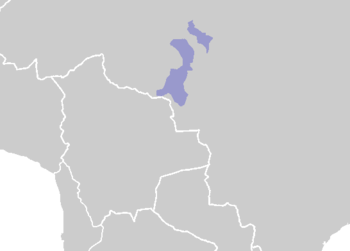- Nambikwaran languages
-
Nambikwaran Geographic
distribution:Mato Grosso, Brazil Linguistic classification: Nambikwaran Subdivisions: Northern (Mamaindé)Sabanê
The Nambikwaran languages are a language family of half a dozen languages, all spoken in the state of Mato Grosso in Brazil. They have traditionally been considered dialects of a single language, but at least three of them are mutually unintelligible. The total number of speakers is estimated to be about 1,500, with Nambikwara proper being 80% of that number.[1]
The following classification is based on Ethnologue and on David Eberhard:[2]
- Northern Nambikwaran (Mamaindê)
- Lakondê (moribund)
- Latundê (20)
- Mamaindê (330, including Nagarotê)
- Tawaindê (Da’wan’du) (moribund)
- Yalakalore (extinct)
- Yalapmunde (?)
- Nambikwara (1200)
- Sabanê (60)
The Northern Nambikwaran languages are often seen as dialects of Mamaindê, but are treated as separate languages by Ethnologue. Sabanê is a single speech community and thus has no dialects, while the Nambikwara language has been described as having eleven.[3]
Most Nambikwara are monolingual but some young men speak Portuguese.[4] Especially the men of the Sabanê group are trilingual, speaking both Portuguese and Mamainde.[5]
References
- ^ Ethnologue: Nambiquaran languages
- ^ Eberhard, David M. (2009). Mamaindê Grammar: A Northern Nambikwara language and its cultural context. Utrecht, Netherlands: Netherlands Graduate School of Linguistics. p. 21. ISBN 978-94-6093-012-6.
- ^ Campbell, Lyle (1997). American Indian languages: the historical linguistics of Native America. Oxford, United Kingdom: Oxford University Press. ISBN 0-19-509427-1.
- ^ Kroeker, 2001 p.1
- ^ Ethnologue
Categories:- Language families
- Languages of Brazil
- Northern Nambikwaran (Mamaindê)
Wikimedia Foundation. 2010.
